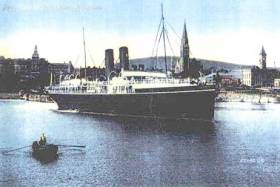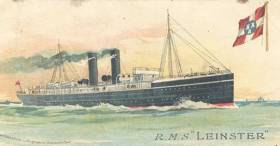Displaying items by tag: Centenary Events
Flotilla from Dun Laoghaire to Head to RMS Leinster Wreck Site off Kish Bank Tomorrow–Centenary Day
#rmsLeinster - A request from the Mail-Boat Leinster Centenary Committee for use of the Naval Service largest patrol vessel to carry out a wreath-laying ceremony at the wreck site off the Kish Bank tomorrow has been declined, writes Jehan Ashmore.
A Naval Press Office spokesperson commented to Afloat.ie that the LÉ Eithne is scheduled for a self-maintenance period during that time and is therefore not available. The self-maintenance is of a routine nature and would have been scheduled last year.
Instead LÉ Orla, a coastal patrol vessel (CPV) has been assigned to carry out duties off the Kish Bank tommorrow morning though on behalf of the navy. Despite the efforts of the Committee they were unable to secure use of the CPV too as the Naval Service did not permit bringing family relatives out to the wreck site of the RMS Leinster. The wreck lies on the seabed in a depth of 28m.
Instead the Committee has chartered Dublin Bay Cruises St.Bridget to bring the relatives. The excursion vessel is to depart tomorrow morning at 07.00 from the jetty at the East Pier, Dun Laoghaire. In attendance will be the Dun Laoghaire Lifeboat though at time of writing confirmation awaited from the Irish Coastguard to send out a helicopter too.
The 100th anniversary tomorrow morning is to mark the tragedy when more than 500 lives were lost from RMS Leinster which having departed Kingstown (Dun Laoghaire) bound for Holyhead, Wales was struck by a German U-Boat torpedo in WW1. This was the single-largest loss of life on the Irish Sea and all the more poignant, given the disaster took place within weeks before the Great War ceased in the following month. For a related story on the City of Dublin Steam Packet operated Royal Mail Steamer (RMS) Leinster click here.
On completion of the offshore centenary commemorative ceremony the flotilla will return to Dun Loaghaire Harbour around 09.00hrs. This will include the LÉ Orla though the CPV will not be made open to the public.
On shore events are planned throughout the day. An Ecumenical Service at 09.30 is to be held in St. Michael's Church on Marine Road. An Official State Commemoration to mark the tragedy of the sinking of RMS Leinster takes place at 11.00 at Moran Park adjacent the dlr Lexicon Library.
For futher information click here and also this link.
The reason why the Mail-Boat committee requested the LÉ Eithne was because the largest vessel in the 8-strong fleet could easily accommodate the relatives out to the wreck site north of the Kish Bank Lighthouse.
Afloat adds that LÉ Eithne has a spacious aft-deck space and a helicopter hanger. In addition the patrol vessel is aptly twinned with the town of Dun Laoghaire.
A second trip by St. Bridget out to the wreck site is to be held tomorrow afternoon at 15:30. This is to facilitate a further 100 families related to the tragedy, most of them living overseas will have their opportunity to visit the site off Dublin Bay, from where RMS Leinster departed Kingston (Dun Laoghaire) a century ago tommorrow on 10th October 1918.
RMS Leinster - Centenary Calendar of Events In October
#RMSLeinster - Centenary events to mark the tragic sinking of RMS Leinster in the Irish Sea during WW1, continue into next month in Dun Laoghaire, notably on 10 October, the day the 'mail-boat' 100 years ago was struck by a German U-Boat torpedo leading to a major loss of life.
On that infamous date in 1918 of Irish maritime history – the RMS Leinster operated by the City of Dublin Steam Packet had set off from Kingstown (Dun Laoghaire) bound for Holyhead, Wales. On board there were 77 crew among them postal-workers and 694 passengers.
The tragedy which struck the 'mail-boat' took place to the east of the Kish Bank lightship when submarine UB-123 torpedoed the ship, leading to the loss of more than 500 lives. To this day the incident remains as the single greatest loss of life in the Irish Sea.
RMS Leinster was one of a quartet named after the provinces of Ireland and the steam packet company was contracted the Royal Mail Service, hence the 'RMS' prefix designated to the ship's name. At the time of the disaster, the twin-propelled ship was camouflaged through paint effects and armed with one 12 pounder and two signal guns.
RMS Leinster Centenary Events
Events to commermorate the RMS Leinster will be held throughout Dun Laoghaire-Rathdown and is organised by the The Mail Boat Leinster Centenary Committee. To consult the centenary events click here from the 'yellow' brochure. For further news updates, click this link.
Among the various event venues, they include the National Maritime Mussuem of Ireland which is hosting a RMS Leinster exhibition. The museum has a detailed listing of events and activities including links providing further detailed information.
Also available is a calendar of events click here for the 'blue' brochure with front cover depicting RMS Leinster.
The museum located next to the dlrLexicon Library (also holding events) aptly overlooks the Carlisle Pier, from where the RMS Leinster departed on its fateful final crossing.





























































